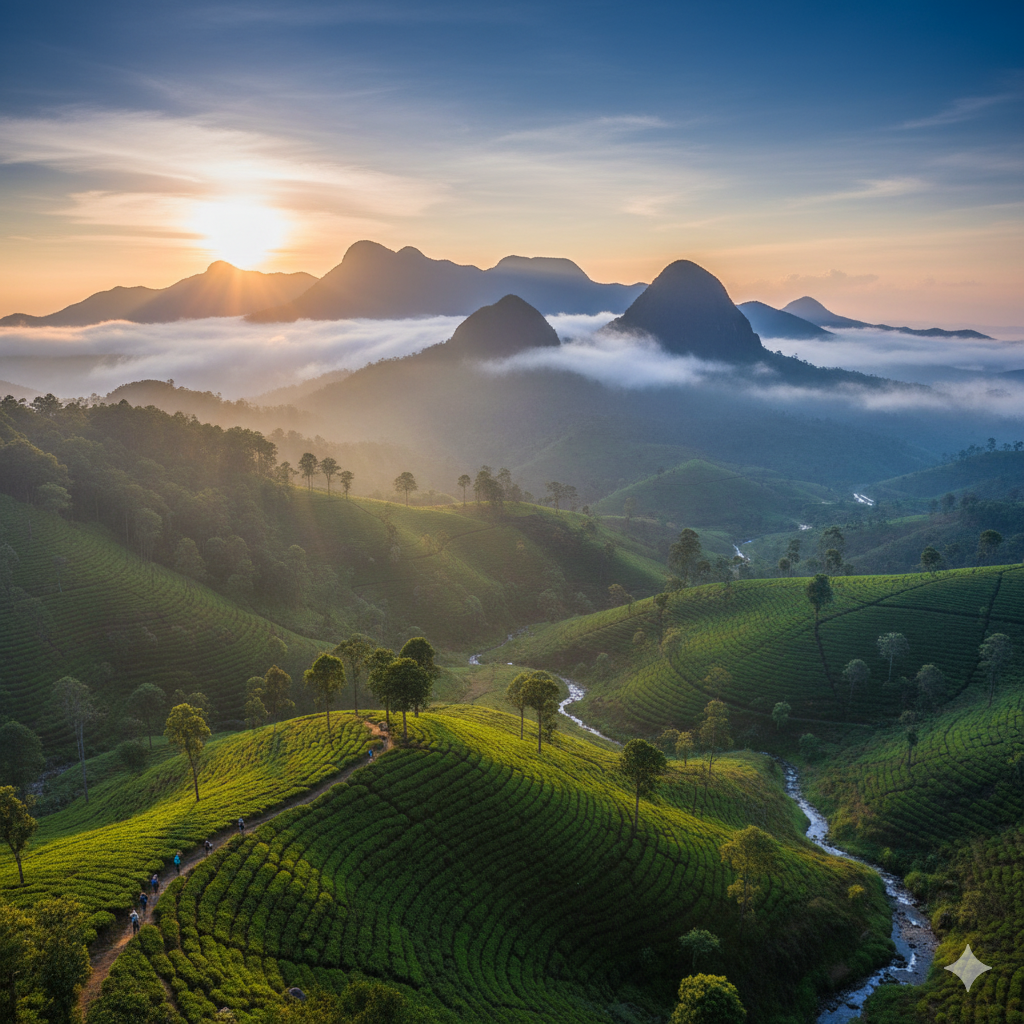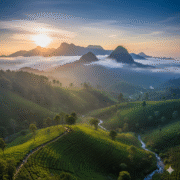
The Knuckles Conservation Forest – Sri Lanka’s Misty Wilderness of Dumbara
- November 14, 2025
- eunoialankatours
- 11:44 pm
The Knuckles Conservation Forest, also known locally as Dumbara Kanduvetiya or the “Misty Mountains of Dumbara,” is a hidden world of mist, folklore, and stunning beauty in Sri Lanka’s central highlands. The peaks look like layers of gentle blues and greens as you get closer, and the sun paints golden streaks across their rough slopes. The five famous peaks of the range soon come into view. They seem like the knuckles of a clinched fist, which is how the mountains got their unique moniker.
Location – The Highlands that Shape Rainfall
The Knuckles Range is between the Dumbara Valley to the south and east and the lush Matale Valley to the west. The mountain rises sharply to 1,906 meters (6,248 feet) and functions as a barrier to the northeast and southwest monsoons, which changes the way rain falls on the island. It is definitely not by chance that some of Sri Lanka’s mightiest rivers, like the Kalu Ganga, Hulu Ganga, and Heen Ganga, have their origins in these highlands.
A Living Mosaic of Ecosystems
The Knuckles Forest is like a realm inside of another world. Because it is between Sri Lanka’s wet and dry zones, it features a unique natural tapestry. You can locate the following inside its 180 km$^2$:
- Cloud forests at higher altitudes, wrapped in mist and dripping with orchids, mosses, and ferns.
- Montane evergreen forests full of wild bamboo, tall trees, and katukítul palms that cling to rocks.
- Riverine forests tracing the path of tumbling streams.
- Grasslands and pygmy forests, such as the famous Pitawala Pathana, where trees that are too short and bent by the wind look like bonsai trees made by nature.
- This diversity shelters over 1,000 species of flowering plants, including 160 endemics — some found nowhere else but the Knuckles itself.
Wildlife – A Haven for the Rare and Endemic
The Knuckles Forest is a great place for anyone who appreciate animals. Sambar deer, barking deer, mouse deer, wild boar, and the hard-to-find slender loris all live here. Troops of purple-faced leaf monkeys jump from branch to branch, while the call of the Sri Lanka blue magpie, which is only found in Sri Lanka, can be heard through the canopy.
Birdwatchers will be happy to know that 17 of Sri Lanka’s 23 native birds, such as the yellow-fronted barbet, dusky-blue flycatcher, and jungle fowl, live here. Herpetologists will also be amazed by the Ceratophora tennentii lizard and the Knuckles shrub frog, which can only be found in this area.
People of the Dumbara Valley
There are about 80 traditional communities around the forest where life still follows the same patterns as it did in the past. Paddy terraces flow smoothly over hills, granaries hold golden harvests, and residential gardens try to copy the forest’s diversity. The fact that these settlements are so far away has kept their cultural customs and way of life alive.
People in the area still rely on the forest for things like chena farming, firewood, spices like cardamom, and forest goods. At the same time, they are learning to take advantage of new eco-tourism prospects. Visitors should treat these villages with respect because their history is closely tied to the land.
Trails, Peaks, and Hidden Wonders
Exploring the Knuckles is like stepping into a storybook. Some of the must-visit highlights include:
- Mini World’s End – a cliff with breathtaking views across the valleys.
- Riverstone Peak (Kirimatiyakanda) – offering panoramic mountain vistas.
- Pitawala Pathana – a unique grassland plateau with pygmy forests.
- Manigala Rock – a dramatic ridge beloved by hikers.
- Gal Oya caves and Alugallena cave – ancient shelters rich in history.
- Thelegamu Oya – a serene natural pool near Illukkumbura.
Nine walking trails and six cycling routes traverse the forest, each offering a new perspective of this natural wonder.
Conservation and Challenges
The Knuckles is still in danger, even though it is protected. Illegal logging, gem mining, growing cardamom in a way that isn’t good for the environment, and throwing trash around carelessly all threaten the forest’s delicate balance. The Forest Department works to protect its biodiversity, but responsible tourism is also very important.
Visitors can support this effort by:
- Purchasing entrance tickets only from official conservation centers.
- Avoiding littering and respecting wildlife.
- Hiring trained local guides to ensure safety and sustainability.
Practical Information
- Entry Points: Deanston, Riverston, and Illukkumbura Conservation Centers.
- Accommodation: Basic lodging and campsites are available at Deanston and Illukkumbura with prior booking.
- Best Time to Visit: December to February for clear skies, though misty weather can enchant year-round.
- Tips: Carry binoculars, be prepared for leeches, sudden weather changes, and always respect the environment and local traditions.
Why the Knuckles Forest Matters
For travelers with Eunoia Lanka Tours, the Knuckles Conservation Forest offers more than just scenery. It is a journey into the heart of Sri Lanka’s natural and cultural soul — where cloud forests meet grasslands, ancient villages meet modern conservation, and every trail whispers stories of life, resilience, and wonder. This is not just a forest. It is a living museum of biodiversity, a sanctuary of tradition, and one of the last great wildernesses of Sri Lanka’s highlands.
Eunoia Lanka Tours invites you to step into the mist of Dumbara, where every breath is fresh, every path an adventure, and every moment a reminder of the island’s Wonder of Diversification.


